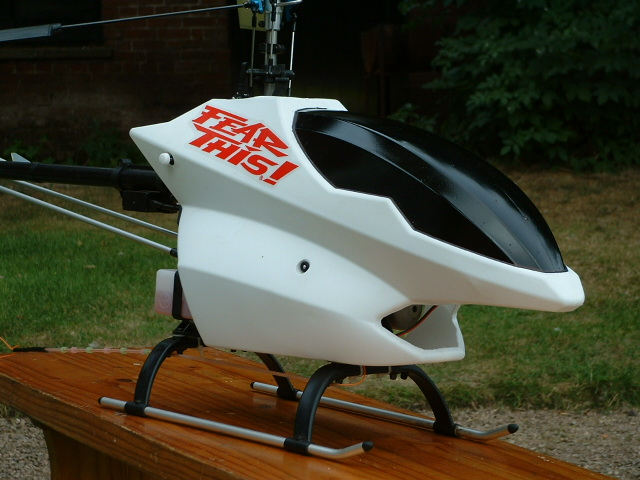Intro To Autos
Well you thought nose in hovering was scary.......wait until you try one of these! Haha I'm getting good at putting doubt in your mind aren't I :)
Really once again these aren't as hard as they are made out to be. An auto is actually a fun way of saving a helicopter should the engine die. Basically what happens is when a helicopter is flying around normally, the positive pitch on the disc sucks air in from the top and blows it out the bottom. Now this is all fine while the drag from the positive pitch is being overcome by power from the engine, but what happens when that power goes? YOU PLUMMET TO YOUR DEATH!......sorry, there I go again. No really, what happens is you drop the collective so the disc has a negative pitch on it, therefore it drops rather fast, but since the air is now coming up from underneath due to the negatie pitch and the falling motion, the blades will keep spinning at a normal speed. Actually me and Jonny witnessed my Raptor blade speed go faster than it does with power, while in an auto, (on a recording we made on a video camera, with the high shutter speed on so you can see the blades), it's all about managing the collective.
|
 |
|
Set Up for Autos
The throttle hold function should be enabled on your transmitter, and the engine should be setup for a reliable idle low enough that the clutch is no way engaged. At full down collective for your first autos, you should set the pitch curve to have no more than -4 degrees, any more than that and all it does is make it drop quicker and use up blade speed pulling the helicopter down. Not enough negative pitch and the helicopter will float down nice and slow but be losing head speed the whole time. For top end pitch you want to set it to pull all your helicopter can mechanically muster, because eery extra degree you can pull is a little extra lift at the bottom, and that is always a good thing.
Hovering Autos
A good practise for autos is the hovering auto. This is where, in a solid 3ft hover, the throttle hold switch should be hit, and the helicopter should settle to the ground with the inertia in the blades. The trick is to leave the helicopter alone for half a second after the power has gone, because lifting the collective too soon will do nothing but shoot the helicopter in the air and drain your headspeed, and then you are stuck 15ft in the air like a brick with the blades going slow enough to count. If you lower the collective it will surely just drop into the ground. So leave it alone until you see it fall slightly, then on the way down cushion it with the collective, it is all about the timing, you should aim to be hitting full collective as the skids touch the ground.
Power Approaches
Another good practise for autos is a power approach. This is a nice easy thing to do, basically get it into fast forward flight, heading into the wind, and about 100ft up. The aim of this little practise is to get the descent of the auto worked out, so the helicopter won't end up way past you of drop too far in front for you too see what it's doing (usually resulting in a tip over). So when you think the time is right, lower the collective all the way to the bottom, since the power is still applied the descent should be safer as a bail-out is an option at any time you think it isn't looking good. Keep working on it until you can get it to 5ft and hover right in front of you, without having to stretch or shorten it. After you've got that down it's time for the real thing!
The Moment of Truth
Fill your tank right to the brim, because once you start doing these, you won't want to be doing anything else! Take off and do some gentle flying around to get the engine up to temperature first, then practise some power on approaches and hovering autos to get warmed up. Next take it into a circuit and put it in the same place you were using for power approaches, and at about 40-50mph, move the collective to the bottom, hit the hold switch, and fall to your knees as your pride and joy plummets to earth at an astounding rate. As the helicopter nears 15ft, ease the nose up gently, only a tiny amount. As it gets to 10ft, pull the nose up a little more and begin feeding in the pitch, being careful not to make it pop up in the air again, and from there on just keep the flare coming in to shed the speed, and its basically a hovering auto, just like you practised! There you go, not as hard as you thought huh? Told you!
|


